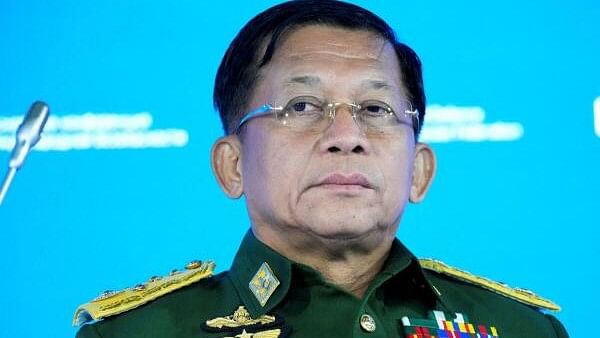
Commander-in-Chief of Myanmar's armed forces, Senior General Min Aung Hlaing attends the IX Moscow conference on international security in Moscow, Russia.
Credit: File Photo
Myanmar has been facing a serious domestic political crisis since the military overthrew the Aung San Suu Kyi’s government in 2021. The situation has continued to worsen as the civil conflict between the rebel groups and the military junta has continued to intensify.
However, for the last three years, Beijing has been working towards maintaining a close relationship with the junta while also trying to balance the rebel groups. In a most recent development the Chinese Ambassador to Myanmar, Ma Jia, met defence minister General Tin Aung San and discussed ways to strengthen military co-operation, training, and border security.
China is also one of the few countries which has continued to invest in Myanmar even after the military coup and the ongoing international sanctions. Chinese investments amount to 25% of the total foreign investment in Myanmar. Beijing has also continued to invest in infrastructure, ports, and electricity projects totalling $22 billion. Such investments make it pertinent for China to be engaged in efforts to safeguard the same, while mitigating the challenges emerging from the ongoing civil war. Myanmar is also crucial for China’s access to the Indian Ocean Region.
No surprise then that in mid-August China’s foreign minister Wang Yi travelled to Myanmar with the hope to establish some sort of peace between the junta and the rebel groups. With the goal of helping the junta strengthen its control over the country, Wang promised to extend interest-free loans to the junta, help in conducting a census and an election too. He also met with the chairman of Myanmar's state administration council (SAC) Senior General Min Aung Hlaing, Myanmar's deputy prime minister and union minister for foreign affairs U Than Swe, and former chairman of the Myanmar state peace and development council Than Shwe.
He said that “China firmly supports Myanmar in maintaining its independence, sovereignty, national unity, and territorial integrity”. Peace in Myanmar is crucial for China as Beijing shares a 2,200-kilometre-long border with Myanmar. However, the developments that followed highlight that the diplomatic route has failed to achieve the expected results.
Just weeks after Wang’s visit, Beijing conducted live fire drills in border regions with Myanmar. The statement highlighted that “the purpose was to test the rapid mobility, three-dimensional control, and joint strike capabilities of the theater troops, as well as to maintain security and stability in the border regions”. A similar drill was conducted in April. The exercises are also a demonstration of the superior Chinese military power and an attempt to deter the rebels from harming Chinese nationals and Beijing’s investments.
In addition to military power, Beijing has also adopted to use its economic clout to push for peace. It has threatened to stop border trade, which has declined because the rebel groups have managed to gain control over the border territories. Trade is an important source of foreign reserve for the junta. The Burmese government cannot afford to lose billions of dollars as this also impacts the people. Given the direction of civil war, the growth forecast for Myanmar’s economy is very bleak, standing at just 1%.
The major factor pushing China to engage in the domestic situation, even while parroting the non-interference stand, is its heavy investments and the fear of instability and refugees across the border. Beijing has been attempting to influence Myanmar’s political outcome hoping to reach an acceptable outcome. The root cause of Chinese focus is the money it has invested and also peace across the border regions. Though Beijing has aligned itself with the junta, the increasing power of the rebel groups underscores a tumultuous future for Myanmar, something which is a challenge for China’s geopolitical aspirations.
An unsettled Myanmar is also a cause of concern for New Delhi. Myanmar plays a vital role in India’s Act East Policy and is crucial for the economic development of India’s Northeastern region. India is also facing the challenge of refugee inflow from Myanmar, and, thus, an early restoration to peace and democracy is crucial.
However, rather than a show of force, India’s course has been to end the free movement of people and fence the border. Though the reasons for the decision are obvious, one cannot deny that this will impact the people on both sides. India should and it can get more engaged in Myanmar as it gains from preventing further escalation of the ongoing humanitarian crisis. New Delhi has been cautious in its approach as it does not want to be perceived as favouring one side over the other.
(Gunjan Singh is Associate Professor, OP Jindal Global University. Author's X handle: @Gunjsingh01)
Disclaimer: The views expressed above are the author's own. They do not necessarily reflect the views of DH.